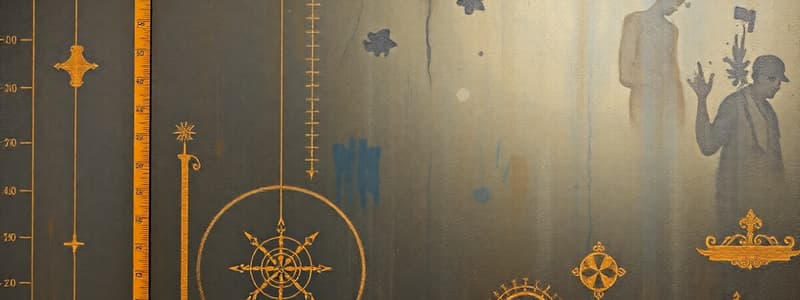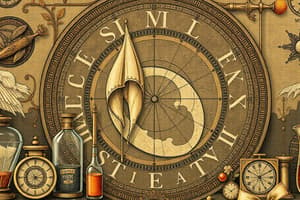Podcast
Questions and Answers
What is one reason that makes the Imperial System less efficient compared to the Metric System?
What is one reason that makes the Imperial System less efficient compared to the Metric System?
- It is based on universal scientific constants.
- It simplifies conversions between different measurements.
- It uses consistent units across different contexts.
- It relies on random objects and units, making it harder to learn. (correct)
How many places does the decimal point move between each metric prefix when converting?
How many places does the decimal point move between each metric prefix when converting?
- Four places
- Three places
- One place (correct)
- Two places
What does it mean to be accurate in a science laboratory?
What does it mean to be accurate in a science laboratory?
- Using the correct lab equipment only.
- Obtaining results that are close to the true value. (correct)
- Producing results that are repeatable.
- Following lab procedures precisely.
What defines accuracy in scientific measurements?
What defines accuracy in scientific measurements?
Which of the following best describes precision in scientific measurements?
Which of the following best describes precision in scientific measurements?
Which metric prefix represents the smallest value in the King Henry Slider method?
Which metric prefix represents the smallest value in the King Henry Slider method?
What is the primary purpose of the initial step in the scientific method?
What is the primary purpose of the initial step in the scientific method?
What is the primary difference between truth and scientific knowledge?
What is the primary difference between truth and scientific knowledge?
Which of the following conversions is accurate based on metric conversion principles?
Which of the following conversions is accurate based on metric conversion principles?
In the scientific method, which step directly follows formulating a hypothesis?
In the scientific method, which step directly follows formulating a hypothesis?
When measurements are precise but not accurate, it indicates what situation?
When measurements are precise but not accurate, it indicates what situation?
Using a ruler carefully to mark measurements is an example of which concept?
Using a ruler carefully to mark measurements is an example of which concept?
Which step involves summarizing data in a clear format without interpretation?
Which step involves summarizing data in a clear format without interpretation?
What is a characteristic of a hypothesis in the scientific method?
What is a characteristic of a hypothesis in the scientific method?
Which of the following steps involves evaluating whether the initial hypothesis was supported or refuted?
Which of the following steps involves evaluating whether the initial hypothesis was supported or refuted?
What is the role of the independent variable in an experiment?
What is the role of the independent variable in an experiment?
Why is it important to only test one independent variable at a time in an experiment?
Why is it important to only test one independent variable at a time in an experiment?
What does the dependent variable represent in an experiment?
What does the dependent variable represent in an experiment?
What purpose does the control group serve in an experimental design?
What purpose does the control group serve in an experimental design?
Why is it important to only test one independent variable in an experiment?
Why is it important to only test one independent variable in an experiment?
Which of the following best describes a lurking variable?
Which of the following best describes a lurking variable?
What is typically measured in an experiment to test the effects of the independent variable?
What is typically measured in an experiment to test the effects of the independent variable?
What is the function of a control group in experimental design?
What is the function of a control group in experimental design?
What are lurking variables in the context of an experiment?
What are lurking variables in the context of an experiment?
What is the primary focus of epistemology?
What is the primary focus of epistemology?
Which of the following best defines a scientific hypothesis?
Which of the following best defines a scientific hypothesis?
How does scientific knowledge differ from truth?
How does scientific knowledge differ from truth?
What characterizes a scientific fact?
What characterizes a scientific fact?
Which statement accurately reflects the nature of a theory?
Which statement accurately reflects the nature of a theory?
What is an atom primarily composed of?
What is an atom primarily composed of?
In the structure of an atom, where are neutrons located?
In the structure of an atom, where are neutrons located?
What does the term 'electron cloud' refer to?
What does the term 'electron cloud' refer to?
Which of the following is NOT a subatomic particle of an atom?
Which of the following is NOT a subatomic particle of an atom?
How are protons and neutrons represented in a basic atom diagram?
How are protons and neutrons represented in a basic atom diagram?
What is the purpose of the 'Research (Background Information)' step in the scientific method?
What is the purpose of the 'Research (Background Information)' step in the scientific method?
Which statement best describes a hypothesis in the context of the scientific method?
Which statement best describes a hypothesis in the context of the scientific method?
What role does the 'Experiment (Procedure)' step play in the scientific method?
What role does the 'Experiment (Procedure)' step play in the scientific method?
In what way does the 'Conclusion (Analyze results and respond to Hypothesis)' step connect to the hypothesis?
In what way does the 'Conclusion (Analyze results and respond to Hypothesis)' step connect to the hypothesis?
How do facts, theories, hypotheses, and experiments interact in the cycle of scientific enterprise?
How do facts, theories, hypotheses, and experiments interact in the cycle of scientific enterprise?
What distinguishes isotopes from one another?
What distinguishes isotopes from one another?
How is atomic mass calculated?
How is atomic mass calculated?
What was Democritus's main contribution to atomic theory?
What was Democritus's main contribution to atomic theory?
What belief did Aristotle hold regarding the existence of atoms?
What belief did Aristotle hold regarding the existence of atoms?
Which analogy best represents Democritus's atomic model?
Which analogy best represents Democritus's atomic model?
What was the primary contribution of Dalton to atomic theory?
What was the primary contribution of Dalton to atomic theory?
Which model describes electrons as being embedded in a positively charged sphere?
Which model describes electrons as being embedded in a positively charged sphere?
What discovery did Chadwick make that significantly impacted atomic theory?
What discovery did Chadwick make that significantly impacted atomic theory?
What aspect of atomic theory did Schrödinger and Heisenberg challenge?
What aspect of atomic theory did Schrödinger and Heisenberg challenge?
Which experiment demonstrated the existence of a dense, positively charged nucleus in the atom?
Which experiment demonstrated the existence of a dense, positively charged nucleus in the atom?
What do Venn diagrams illustrate in the context of atomic theory?
What do Venn diagrams illustrate in the context of atomic theory?
Which statement accurately reflects Bohr's contribution to atomic theory?
Which statement accurately reflects Bohr's contribution to atomic theory?
What was a significant improvement in atomic models over time?
What was a significant improvement in atomic models over time?
Flashcards
Epistemology
Epistemology
The study of knowledge, how we acquire it, and its limitations.
Truth
Truth
The way things really are, independent of our beliefs or opinions.
Scientific Fact
Scientific Fact
Knowledge gained from experiments and observations, considered to be reliable and accurate.
Hypothesis
Hypothesis
Signup and view all the flashcards
Theory
Theory
Signup and view all the flashcards
Accuracy
Accuracy
Signup and view all the flashcards
Precision
Precision
Signup and view all the flashcards
Metric Conversion
Metric Conversion
Signup and view all the flashcards
Significant Figures
Significant Figures
Signup and view all the flashcards
Tools and Precision
Tools and Precision
Signup and view all the flashcards
Metric System
Metric System
Signup and view all the flashcards
King Henry Slider
King Henry Slider
Signup and view all the flashcards
Metric Prefix Order
Metric Prefix Order
Signup and view all the flashcards
Decimal Shift in Metric Conversions
Decimal Shift in Metric Conversions
Signup and view all the flashcards
Imperial System
Imperial System
Signup and view all the flashcards
Independent Variable
Independent Variable
Signup and view all the flashcards
Dependent Variable
Dependent Variable
Signup and view all the flashcards
Lurking Variable
Lurking Variable
Signup and view all the flashcards
Why only one independent variable?
Why only one independent variable?
Signup and view all the flashcards
Control Group's Role
Control Group's Role
Signup and view all the flashcards
What is an atom?
What is an atom?
Signup and view all the flashcards
What are the main parts of an atom?
What are the main parts of an atom?
Signup and view all the flashcards
Protons
Protons
Signup and view all the flashcards
Neutrons
Neutrons
Signup and view all the flashcards
Electrons
Electrons
Signup and view all the flashcards
Isotopes
Isotopes
Signup and view all the flashcards
Atomic Mass
Atomic Mass
Signup and view all the flashcards
Democritus's Contribution
Democritus's Contribution
Signup and view all the flashcards
Aristotle's View on Matter
Aristotle's View on Matter
Signup and view all the flashcards
Atomic Models
Atomic Models
Signup and view all the flashcards
Scientific Method: Purpose
Scientific Method: Purpose
Signup and view all the flashcards
Scientific Method: Hypothesis
Scientific Method: Hypothesis
Signup and view all the flashcards
Scientific Method: Experiment
Scientific Method: Experiment
Signup and view all the flashcards
Scientific Method: Results
Scientific Method: Results
Signup and view all the flashcards
Scientific Method: Conclusion
Scientific Method: Conclusion
Signup and view all the flashcards
Scientific Method
Scientific Method
Signup and view all the flashcards
Experiment
Experiment
Signup and view all the flashcards
Data Analysis
Data Analysis
Signup and view all the flashcards
Conclusion
Conclusion
Signup and view all the flashcards
Why test one variable at a time?
Why test one variable at a time?
Signup and view all the flashcards
Control Group
Control Group
Signup and view all the flashcards
Dalton's Atomic Theory
Dalton's Atomic Theory
Signup and view all the flashcards
Thomson's Plum Pudding Model
Thomson's Plum Pudding Model
Signup and view all the flashcards
Rutherford's Gold Foil Experiment
Rutherford's Gold Foil Experiment
Signup and view all the flashcards
Bohr's Atomic Model
Bohr's Atomic Model
Signup and view all the flashcards
Chadwick's Discovery
Chadwick's Discovery
Signup and view all the flashcards
Uncertainty Principle
Uncertainty Principle
Signup and view all the flashcards
Electron Cloud Model
Electron Cloud Model
Signup and view all the flashcards
Atomic Model Evolution
Atomic Model Evolution
Signup and view all the flashcards



